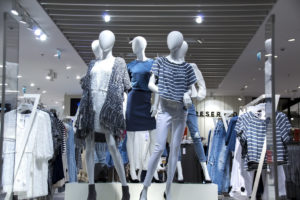Shoplifting crimes increase every year. Mall security, loss prevention personnel and police departments across the nation work together to prevent shoplifting. But, that is not enough. The National Association for Shoplifting Prevention states that the United States loses billions of dollars every year due to shoplifting, and those statistics are not getting better. Police departments across the nation are constantly called to these retail store due to a shoplifting incident that they have to take care of. By knowing what the response to a shoplifting is, your employees can readily take care of the problem without jeopardizing their safety.
For more about this and othe r topics, follow the links below.
Winnipeg mom carrying diaper bag refused entry to Canadian Tire
What was supposed to be a quick pit stop at a local Canadian Tire has left a Winnipeg mom angry and speaking out.
On Friday, Stephanie Stachowich was trying to go shopping at the Regent Avenue location to buy a few items.
She had her two daughters, 3-years-old and 7-months-old, with her and was carrying a diaper bag filled with necessities along with her keys and wallet.
“As I walked in I saw a staff member spot me right away,” Stachowich told Global News. “She simply told me straight out I could not bring my diaper bag into the store.”
Stachowich said there were no signs regarding bag policies posted and she wasn’t given a choice to have her bag searched or checked. She was simply told the diaper bag was not allowed in the store.
Theft and drugs having affects on Retail business
A panel of retail and law enforcement representatives discussed recent trends related to drug laws, sentencing reform and retail theft at the Council of State Retail Association’s (CSRA) Annual Meeting in Portland earlier this month.
The topic resonated with the audience for several reasons. The link between drug addiction and property crimes is well-known and drives many policy discussions related to criminal justice reform. And retailers have a front row seat to witness the effects of both addiction and changes in sentencing guidelines.
After voters passed Proposition 47 in 2014, California implemented some of the nation’s sharpest reductions in penalties, reducing many drug-related and theft crimes to misdemeanors. Property crimes in many counties have increased more than 25% since the ballot measure passed and made all thefts of less than $950 a misdemeanor.
Another factor driving up thefts has been the opioid crisis, said Sacramento County District Attorney Anne Marie Schubert. Some California counties had more opioid prescriptions than people in 2016, she said, citing a Sacramento Bee article. (To read the article, click here.)
Convenience store manager fires gun after shoplifting incident
INDIANAPOLIS (WTHR) – An E. Washington St. convenience store manager is under investigation for firing his gun at a shoplifter.
It happened Monday night at Sam’s Food Mart & Tobacco Store.
Eyewitness News spoke with one of the store clerks about why the manager decided to fire his weapon.
The clerk said the shooting happened after his co-worker chased a customer through the front door and into the parking lot. The shoplifter left with a couple of items without paying for them.
Someone flagged down an IMPD officer to report the incident.
Eyewitness News has learned the shoplifter stole a bag of Planters peanuts and a package of Hostess Zingers.



 Turnover for many businesses can be a real headache. You take the time to post job ads, review job applications, set up interviews and then conduct the interviews. Your new hire starts and within a couple of weeks they quit. It happens far too many times and it is a pain. Why did the person quit? Did they have a propensity for job hopping already and you missed it on the job application? Did they start stealing from you and got enough money or merchandise and quit before you caught on to their schemes? Perhaps it was a young employee on their first job and they wanted more weekends and night shifts off so they could “hang out” with their friends. All of these are reasons for high turnover in retail stores especially. Lose too many people at once and it can cripple your business, stretch the staff you currently have and it may potentially lead to more employees quitting.
Turnover for many businesses can be a real headache. You take the time to post job ads, review job applications, set up interviews and then conduct the interviews. Your new hire starts and within a couple of weeks they quit. It happens far too many times and it is a pain. Why did the person quit? Did they have a propensity for job hopping already and you missed it on the job application? Did they start stealing from you and got enough money or merchandise and quit before you caught on to their schemes? Perhaps it was a young employee on their first job and they wanted more weekends and night shifts off so they could “hang out” with their friends. All of these are reasons for high turnover in retail stores especially. Lose too many people at once and it can cripple your business, stretch the staff you currently have and it may potentially lead to more employees quitting. Retail shelving along with store design has a huge impact on shoplifting losses. Typically a shoplifter likes and needs privacy even if only for a moment. So why not keep that in mind when designing or remodeling your store. Your shelving and isles can work for you by simply considering several factors.
Retail shelving along with store design has a huge impact on shoplifting losses. Typically a shoplifter likes and needs privacy even if only for a moment. So why not keep that in mind when designing or remodeling your store. Your shelving and isles can work for you by simply considering several factors. Growing up did you ever do something dumb and your mom or your dad would ask you, “What were you thinking?” Having lived in south for the past 32 years I have learned of the local colloquialism when someone does something stupid, “Didn’t your momma teach you better?” Unfortunately, as a young boy I did a lot of dumb things making me wonder if my brain developed a lot later in life than most people. For example, I had a propensity for walking behind batters warming up to go to the plate for my father’s teen baseball teams. I ended up with more than one fat lip from my stupidity…obviously not learning the lesson the first time. I had a fascination with electrical outlets and wires and old rotary dial telephones…I won’t go into details but no they didn’t work when the wires were pushed into the outlet, I was not injured but I had one very busy guardian angel.
Growing up did you ever do something dumb and your mom or your dad would ask you, “What were you thinking?” Having lived in south for the past 32 years I have learned of the local colloquialism when someone does something stupid, “Didn’t your momma teach you better?” Unfortunately, as a young boy I did a lot of dumb things making me wonder if my brain developed a lot later in life than most people. For example, I had a propensity for walking behind batters warming up to go to the plate for my father’s teen baseball teams. I ended up with more than one fat lip from my stupidity…obviously not learning the lesson the first time. I had a fascination with electrical outlets and wires and old rotary dial telephones…I won’t go into details but no they didn’t work when the wires were pushed into the outlet, I was not injured but I had one very busy guardian angel. Loss Prevention Officers and Managers catch shoplifters and dishonest employees. That is a common perception and in some stores it may be a true picture of what Loss Prevention departments do, with the additional caveat that they may have uniformed people who conduct receipt checks. If this is all that the department does it can be hard to sell store managers on the value of having them on staff if the budget for them comes directly from the store. It is even more difficult for small, independent retailers to justify hiring a Loss Prevention Officer although if the store is in a high crime area they may contract a security guard. There was a time when there was an “us versus them” mindset between store managers and Loss Prevention teams. Over time some larger companies have focused their Loss Prevention teams more on operational issues. For example, I worked for a company that had Loss Prevention conduct food product out of date audits. Their position was that this was a safety issue so it fell to the Loss Prevention team. I had no problem doing the audits, but as I looked at the amount of out of date items I was finding I had to question what the freight team was doing when they were stocking. Who was auditing their work because there were a lot of FIFO (First In First Out) issues I was identifying that were causing out of date problems.
Loss Prevention Officers and Managers catch shoplifters and dishonest employees. That is a common perception and in some stores it may be a true picture of what Loss Prevention departments do, with the additional caveat that they may have uniformed people who conduct receipt checks. If this is all that the department does it can be hard to sell store managers on the value of having them on staff if the budget for them comes directly from the store. It is even more difficult for small, independent retailers to justify hiring a Loss Prevention Officer although if the store is in a high crime area they may contract a security guard. There was a time when there was an “us versus them” mindset between store managers and Loss Prevention teams. Over time some larger companies have focused their Loss Prevention teams more on operational issues. For example, I worked for a company that had Loss Prevention conduct food product out of date audits. Their position was that this was a safety issue so it fell to the Loss Prevention team. I had no problem doing the audits, but as I looked at the amount of out of date items I was finding I had to question what the freight team was doing when they were stocking. Who was auditing their work because there were a lot of FIFO (First In First Out) issues I was identifying that were causing out of date problems.
 If you believe that you can outsell your cash or inventory losses due to theft, you probably won’t be in business for long. Or if you do survive, you are no way living up to the margins you deserve. In my 35+ years of loss prevention particularly helping medium to small retailers, I have heard this more times than I can believe.
If you believe that you can outsell your cash or inventory losses due to theft, you probably won’t be in business for long. Or if you do survive, you are no way living up to the margins you deserve. In my 35+ years of loss prevention particularly helping medium to small retailers, I have heard this more times than I can believe. 